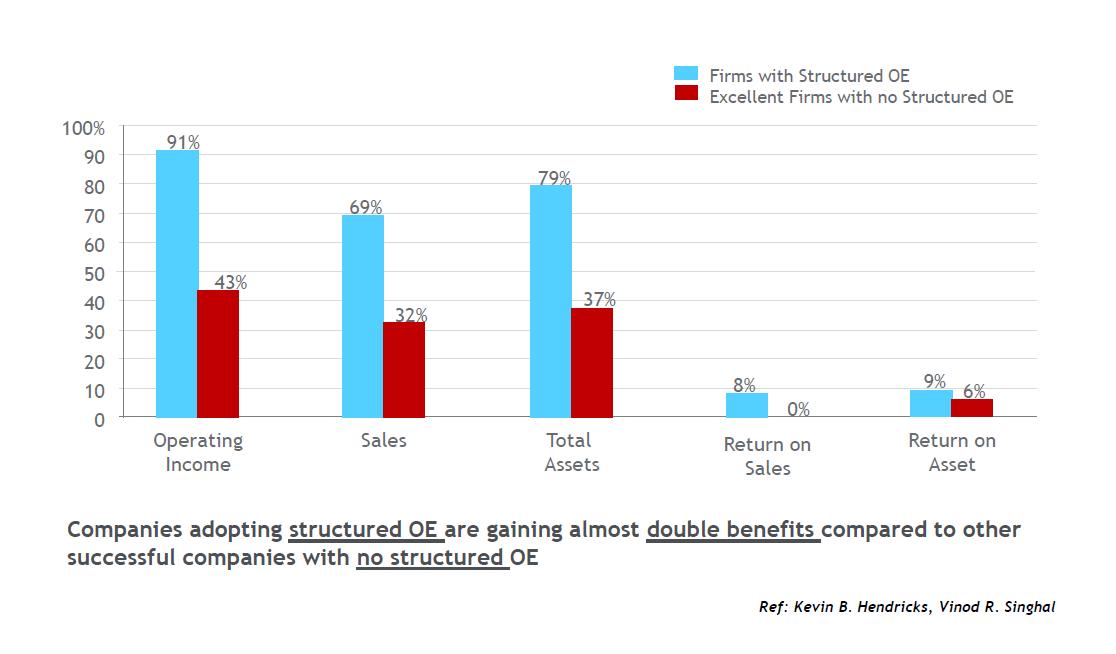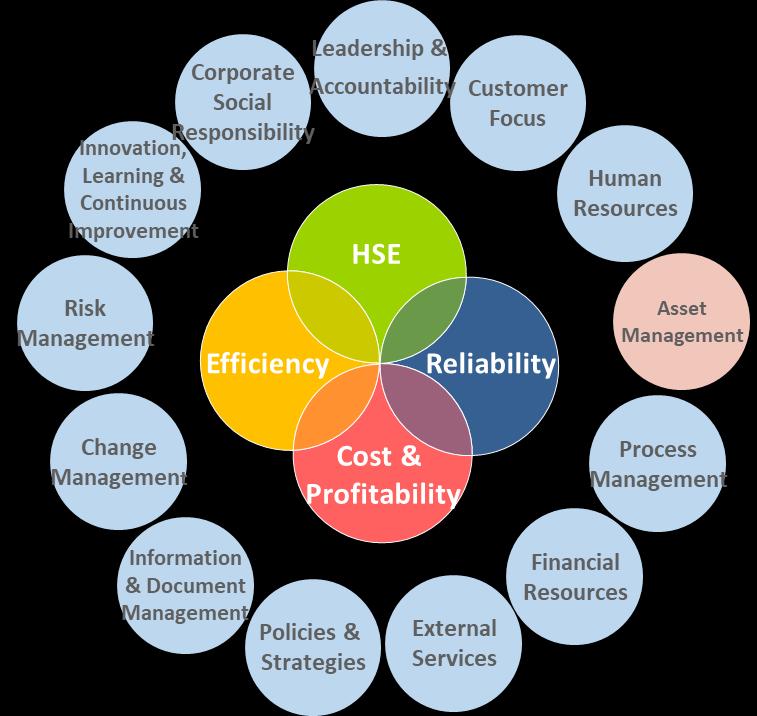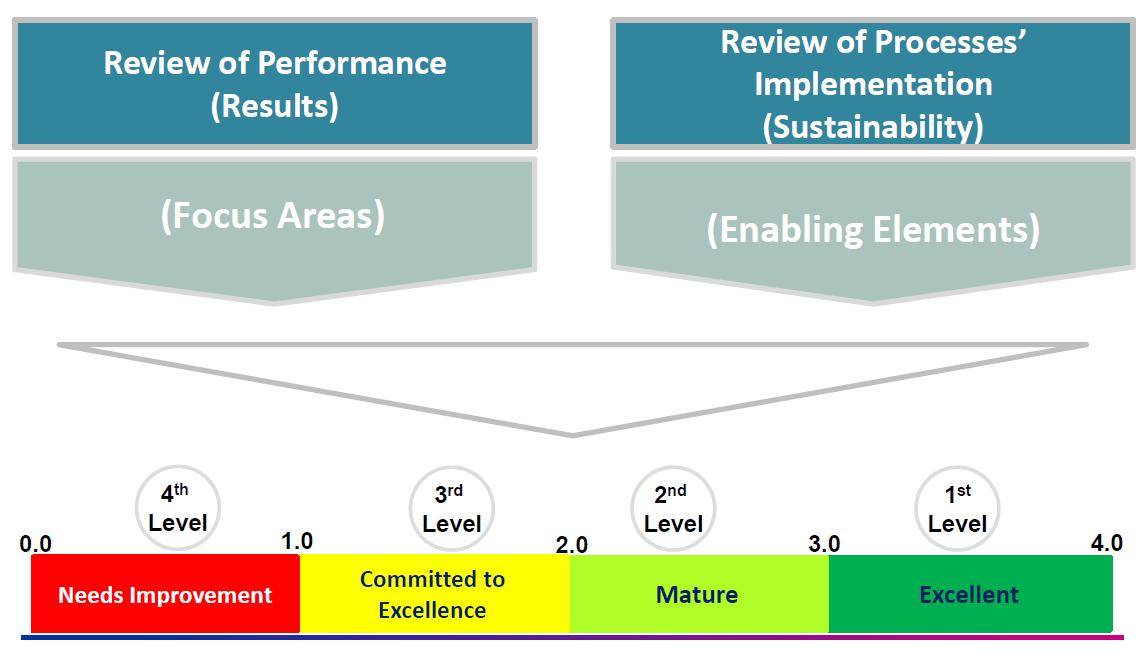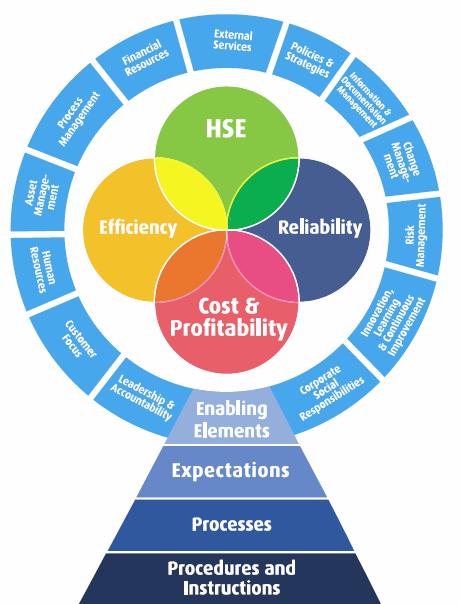ISSN 2348-1196 (print)
International Journal of Computer Science and Information Technology Research ISSN 2348-120X (online) Vol. 8, Issue 4, pp: (39-45), Month: October - December 2020, Available at: www.researchpublish.com

ISSN 2348-1196 (print)
International Journal of Computer Science and Information Technology Research ISSN 2348-120X (online) Vol. 8, Issue 4, pp: (39-45), Month: October - December 2020, Available at: www.researchpublish.com
Saudi Aramco, Dhahran, Saudi Arabia
Abstract: This paper will explore the overall concept of an Operational Excellence (OE) framework, and the Operational Excellence journey undertaken to achieve the highest levels of Operational Excellence and performance in an organization.
Keywords: Operational Excellence (OE), Objectives, Benefits, Model, Implementation, Assessment, Governance, Enabling Elements.
OE is an overarching framework that integrates many existing management systems and best practices to consistently and systematically achieve and sustain industry leading performance in terms of reliability, efficiency, cost effectiveness, and profitability; while striving for the highest levels of performance in health, safety, security and environmental stewardship. The goal of OE is to optimize the organization’s processes to deliver a more agile, flexible and efficient company. Therefore, OE touches the day-to-day activities of each and every employee and organization within the Company.
The introduction of OE to the organization in a structured way will further enhance performance by:
Unleashing the company's full potential.
Standardizing existing areas of excellence within the Company and establishing them as minimum requirements for all organizations to achieve.
Helping Company organizations identify missing best practices and processes deemed essential to achieving and sustaining best performance.
Providing a unified approach or common language to enhance knowledge sharing.
Providing a structured approach to measure performance and sustain improvements.
OE Objectives:
Operational Excellence (OE) aims to consistently and systematically achieve and sustain industry leading performance in:
Reliability
Cost & Profitability
Health, Safety, Security and Environment
OE Benefits:
Operational Excellence (OE) offers many benefits including:
Unleash innate potential
Enhance knowledge sharing
ISSN 2348-1196 (print)
International Journal of Computer Science and Information Technology Research ISSN 2348-120X (online) Vol. 8, Issue 4, pp: (39-45), Month: October - December 2020, Available at: www.researchpublish.com
Standardize pockets of excellence
Sustain performance improvements

Capture best practices
OE is composed of four main components that define what it means for an organization and how to make it the Company way of doing business. The OE components are:
This component defines what any organization within company should do to achieve and sustain excellence. It consists of the Company's four OE Focus Areas and 13 Enabling Elements (as shown in the figure below).

ISSN 2348-1196 (print)
International Journal of Computer Science and Information Technology Research ISSN 2348-120X (online) Vol. 8, Issue 4, pp: (39-45), Month: October - December 2020, Available at: www.researchpublish.com
As the name "Enabling Element" implies, these elements are what enable Company organizations to achieve and sustain excellence. These Enabling Elements are interlinked and all are required. No one single element is adequate on its own. Under each of the 13 Enabling Elements is a set of expectations that describes what needs to be done with respect to the Enabling Element to ensure that it effects the desired change. For more details, refer to OE Model document.
The second OE component is implementation guide, which defines how to achieve and sustain OE through defined processes, procedures and best practices, which are used in a consistent and standardized manner yet without inhibiting flexibility and creativity. They should be embedded in the day-to-day activities of company employees to ensure that OE expectations are translated into action, and excellence is reflected in everything we do. The Implementation Component also identifies techniques and tactics for implementing OE, while at the same time addressing the fundamental cultural and behavioural changes required to produce the right results within every organization.
This component is designed to periodically assess the level of excellence achieved by each organization within the company and identify improvement opportunities. The OE assessment process examines the target organization from two perspectives; it examines the performance of the organization in delivering results in the Focus Areas, and it evaluates the organization's ability to sustain performance and drive improvements though the thirteen Enabling Elements. The overall score of the OE assessment is the aggregate of the assessment scores for the Focus Areas and Enabling Elements as shown in the figure below.

This component comprises the local and corporate OE entities established to keep the OE process alive and dynamic in addition to supporting OE implementation and assessment activities. A newly established organization is the coordinating OE entity responsible for, among other functions, leading OE implementation across the Company organizations, managing OE periodic reviews and updates, and administering OE assessments for all company organizations. Local OE entities are composed of a combination of full and part-time representatives integrated within the organizational structure of business lines, administrative areas, and departments. Local OE governance groups are responsible for leading implementation within their respective organizational boundaries, reviewing progress of OE implementation and enhancing internal processes and practices, as necessary.
ISSN 2348-1196 (print)
International Journal of Computer Science and Information Technology Research ISSN 2348-120X (online) Vol. 8, Issue 4, pp: (39-45), Month: October - December 2020, Available at: www.researchpublish.com
Under Leadership the focus is around the development of a team for the establishment of the department’s Vision (aligned to the Company), Mission (considering the dept. functions, products and service), development of departmental strategies, communication of the Vision, Mission and Strategies, effectiveness of the communication and identified improvements, through other OE processes through lessons learned, root cause analysis, etc.
The Admin Area guidelines are utilized to translate the organization strategies into a 3-year Business Plan (BP), communicate the BP, and assign BP initiatives to champions, and regularly update the progress of the BP Initiatives and review of controllable costs.
Finally, Leadership addresses commitment to OE and the OE culture, by securing resources to oversee the OE implementation, share various corporate standards, develop OE goals, conduct OE internal assessments, and provide improvement feedback.
Customer Focus centres on the Customer Identification, Customer Requirements and then Monitoring and Improvement of Customer Satisfaction. The processes revolve around identifying and classifying customers, required services, developing and reviewing customer forecasts, developing agreements (covering scope, terms & conditions, roles & responsibilities, etc. With respect to service delivery, QA is conducted on services and periodic customer surveys, and feedback is provided for improvements, maintaining KPIs, and implemented improvements.
HR covers the key processes for identifying future job roles, which includes the knowledge and skills required to deliver BPs. This encompasses the forecast of attrition factors, evaluation of current talent, and identification of gaps. It also includes mechanisms to close the gaps through building a hiring strategy, as well the formation of a hiring committee to implement the related strategies.
With respect to managing employee performance, the communication of the business goals and identification of collaboration opportunities are important. The Performance Management Program (PMP) in the context of business goals, employee development and career goals is discussed and translated into SMART goals. Through managing and coaching the identification of changes to business goals and possible revision of PMP goals are facilitated, as well as regular discussion on performance expectations and results.
Employee engagement is focused on the Four Critical Behaviours (4CB), their related survey participation and engagement, identifying areas to be addressed and a 4CB action plan, implementation of the plan and monitoring of progress and tracking KPIs to recognize progress.
Asset Management refers to processes, practices, and disciplines and systems applied to ensure that performance critical assets (i.e., facilities, systems and equipment) are designed, fabricated, constructed, operated, inspected and maintained to ensure high levels of operational reliability, integrity, and efficiency consistent with performance objectives in all focus areas, throughout the asset life cycle. In particular, expectations and standards.
Within the Process Management area, a review of the organization’s functions and identification of a need for any new processes are addressed. The review entails the identification, design, documentation, implementation as well as the continuous monitoring, measurement and improvement of organizational processes. Process Management also covers the application development lifecycle.
This process provides guidelines to ensure efficient resource utilization; the resources yield direct and significant impact, reflecting effective utilization of company’s financial capabilities and strengthening our costs for competitive advantage.
ISSN 2348-1196 (print)
International Journal of Computer Science and Information Technology Research ISSN 2348-120X (online) Vol. 8, Issue 4, pp: (39-45), Month: October - December 2020, Available at: www.researchpublish.com
Thus, it covers the development of reasonable business plans aligned to corporate objectives and compliance; and the review, reporting, monitoring, and revision of financial resources based on periodic progress reviews.
The External Services Element addresses the Services Contract Procurement & Administration as well as Material Procurement processes.
This covers the identification of the need and list of services to procure, development of scope of work (SOW), conduct technical evaluations, estimate and generate services forecasts, which is ultimately reflected in the Business Plan.
The process also covers risk assessments covering scope, quality, time and cost, the development of required procurement documents and expectation setting (delivery time, location, technical specifications, HSE requirements, measures); review of bids and awarding of contracts to execute the work until proper final release and contract closure. As always, we should incorporate lessons learned to be incorporated into any new procurement plan.
In essence, the process within this element covers the guidelines for the organization to identify, understand, communicate and update both internal and external policies developed.
A Communications & Understanding Policies Team is assigned, which determines all corporate policies related to the organization functions. It coordinates developing the organization’s internal policies and a matrix to include related policy categories (such as Operations, Maintenance, HR, Finance, etc.), assign responsibility, level of sensitivity, level of communications and communication medium.
Communicate the policies to employees and conduct periodic internal assessments, close reported gaps in communication, understanding or compliance of policies, recommend adjustments to related policies.
Processes under this Element focus on identification of information to be communicated, their classifications and sensitivity, the development of a Communication Matrix and its implementation with assessments of communication effectiveness; lastly, adjustment of the communication matrix.
The expectation of the processes under the CM Element outlines a Management of Change (MOC) framework, which supports planning processes and the decision making in the organization. It provides guidelines to effectively manage permanent and temporary changes based on sound CM principles and strategies, typically including:
Involvement of all stakeholders (e.g., leadership, experts and others).
Assessing the impact of the change on the organization, its people and other internal and external stakeholders.
Proper approval authority.
Development, tracking, implementation, and close-out of change management plans.
Monitoring and tracking of implementation and expiration of temporary changes.
Training on, and communication of, changes and change impacts.
In our areas, we need to be cognizant of how the combination of technology and applications impact the Company’s business operations and our stakeholders.
The Risk Management element contains three processes namely: Risk Management, Business Continuity Management (BCM) and Emergency Preparedness.
ISSN 2348-1196 (print)
International Journal of Computer Science and Information Technology Research ISSN 2348-120X (online) Vol. 8, Issue 4, pp: (39-45), Month: October - December 2020, Available at: www.researchpublish.com
The Risk Management process covers the department’s objectives, understanding the internal and external context, and preparing a Risk Management Plan. Risks to the organization’s objectives are identified, including causes and consequences, and formulating a Risk Register. Existing controls are identified, analyzed and assigned to owners. Subsequently, plans to treat risks in the form of a treatment plan with assigned actions and dates for implementation and periodic monitoring and updates.
The expectation from BCM supports the organization in developing, communicating, and implementing business continuity plans for responding to and recovering from incidents and unplanned events that will affect the critical functions of the organization. This includes identifying all resources required to manage business disruptions during incidents such as personnel, workplace, facilities, information technology and communication, supply chain and vital records.
The expectation for Emergency Preparedness supports the organization in developing, communicating, and implementing plans for responding to incidents and unplanned events that will negatively affect the safety of personnel, environment, and assets. This will include identifying qualified personnel and assigning adequate resources to manage response and recovery during emergencies.
12)Innovation,
The Innovation, Learning & Continuous Improvement Elements constitutes five Processes, namely:
Innovative Idea Generation, Development and Implementation
Root Cause Analysis
Benchmarking
Performance Monitoring
Knowledge Management
Continuous Improvement
The Innovative Idea Generation, Development and Implementation process is involved with the establishment of an Internal Innovation & Idea Program, the communication of the program, and encouragement to participate. The evaluation and implementation of accepted ideas and finally appropriate rewards and recognition of ideas.
The Root Cause Analysis process focusses on the reporting of performance problems (e.g., operations, equipment failures) and incidents, conducting preliminary analysis, the formation of an investigative team that applies root cause analysis, implements the recommendations, and tracks progress, and finally shares lessons learned.
The Benchmarking process looks at the Planning of Benchmarking Initiative, identifying the scope, collecting benchmarking data, analysis of the data and reporting the findings, and finally adapting the learning and closing gaps.
The Performance Monitoring process is honed toward the determination of success factors, selection and development of KPIs, performance target setting, and monitoring of performance.
The Knowledge Management process focusses on the promotion of knowledge management, embedding KM assets and practices, the capture and organizing of knowledge, disseminating of knowledge, and monitoring and expansion of KM.
The Continuous Improvement process assesses OE processes by conducting self-assessments, identifying improvement opportunities from the assessments, revising or updating processes and procedures, and tracking the implementation through Actions Plans.
Finally, the Knowledge Transfer process focusses on the establishment of a KT Program, assessing employees’ knowledge and skills, planning knowledge transfer by conducting KT training by means of KT plans, and applying and sustaining KT through the implementation of the KT Plan, monitoring of the implementation, and identifying improvement opportunities, implementing improvements, and sustaining KT activities.
ISSN 2348-1196 (print)
International Journal of Computer Science and Information Technology Research ISSN 2348-120X (online) Vol. 8, Issue 4, pp: (39-45), Month: October - December 2020, Available at: www.researchpublish.com
[1] Companies adopting structured OE are gaining almost double benefits compared to other successful companies with no structured OE (Kevin B. Hendricks, Vinod R. Singhal)
